 Back to selection
Back to selection
Shutter Angles
Conversations with DPs, directors and below-the-line crew by Matt Mulcahey
“The Ceilings were Only 8 1/2 Feet High”: DP Tami Reiker on Shooting One Night in Miami with Jibs and Finishing Production after COVID
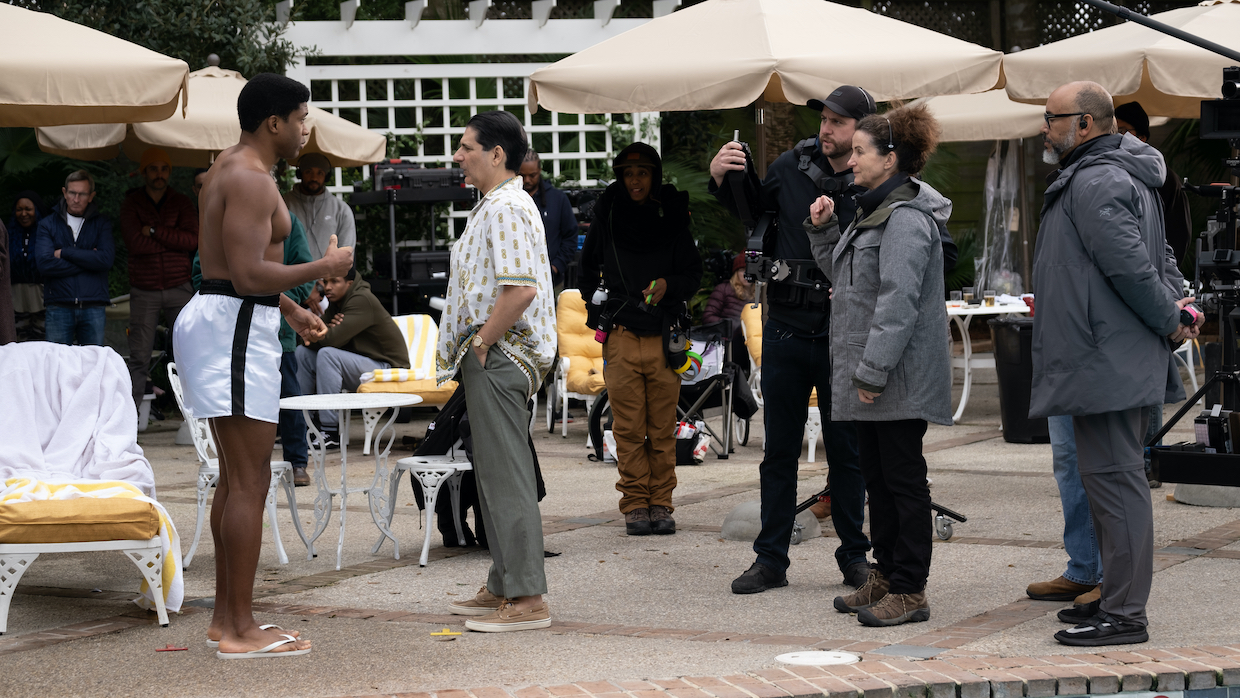 On the set of One Night in Miami (Photo by Patti Perret/courtesy of Amazon Studios)
On the set of One Night in Miami (Photo by Patti Perret/courtesy of Amazon Studios) In February of 1964, Cassius Clay defeated Sonny Liston at the Miami Beach Convention Hall to become the heavyweight champion of the world at the age of 22. He spent the night celebrating with Malcolm X, Jim Brown and Sam Cooke. Within two weeks of the fight, Clay announced his membership in the Nation of Islam and changed his name. Within a year, both Cooke and Malcolm X were shot dead. By the summer of 1966, Brown had retired from football at the age of 30. Based on the 2013 play by Kemp Powers, One Night in Miami offers a fictitious supposition of what these men—whose lives would soon experience such dramatic shifts—might have discussed during that evening of revelry.
Despite its stage origins and a setting largely restricted to a single motel room, One Night in Miami never feels hermetically sealed thanks to the approach of cinematographer Tami Reiker, a veteran of the 1990s New York City indie films scene (The Incredibly True Adventure of Two Girls in Love, High Art) who also shot this year’s $70 million Netflix superhero action movie The Old Guard.
With One Night in Miami still in theaters and now available on Amazon Prime, Reiker spoke to Filmmaker about using jibs to breathe life into the motel room set, finishing the movie after a four-month Covid pause and an early “film job” as an insurance fraud investigator
Filmmaker: I came across an interview you did for American Cinematographer where you were asked about your first break in the business and I need so many more details about your answer. You worked for a private detective doing insurance fraud investigations?
Reiker: Yes. (laughs) I got the job after I went to NYU. It was passed on from a friend who told me, “You have a 16mm Éclair. You shoot the headline of the NY Post that day [to verify the date], then drive around with this detective looking for your medical case.” You know, the person claims their arm is damaged and we try to catch them playing tennis or something. I would sit in the back of the car, the detective would sit in the front and we would drive all over following people. If we caught them, I had to jump out with the Éclair and follow them wherever they went.
Filmmaker: Did you just need a job or were you thinking, “Now I’m in the film business?”
Reiker: They paid $400 a day, I was like 22 years old, so it was amazing. (laughs) I couldn’t do it for very long, though. It was just too boring. I was reading like three books a day sitting in the back of that car. So, I passed the job on to another friend of mine from NYU.
Filmmaker: Did you ever get spotted by someone you were tailing and have to make a run for it with the Éclair?
Reiker: No, but the friend that I gave it to followed a person to the airport and had to get on the same plane that they were getting on. He ended up in Miami with nothing, just his wallet, and stayed in a hotel for four days while he kept following the person. He ended up having to testify at the trial. I was lucky. I didn’t have to go through any of that.
Filmmaker: Your friend stuck in Miami trailing insurance fraudsters—I guess we can use that to segue into One Night in Miami. The majority of the movie takes place over one night in Malcolm X’s Hampton House motel room. Where did you shoot your interiors and exteriors for that location?
Reiker: The Hampton House still exists in Miami, but it’s been renovated. [Production designer] Barry Robison found an older hotel about an hour-and-a-half from New Orleans in Thibodaux, Louisiana. Production rented it out for this big chunk of time and Barry did an incredible job turning it into the exterior of the Hampton House. For the actual room, we built that on stage in a rec center in LaPlace, Louisiana.
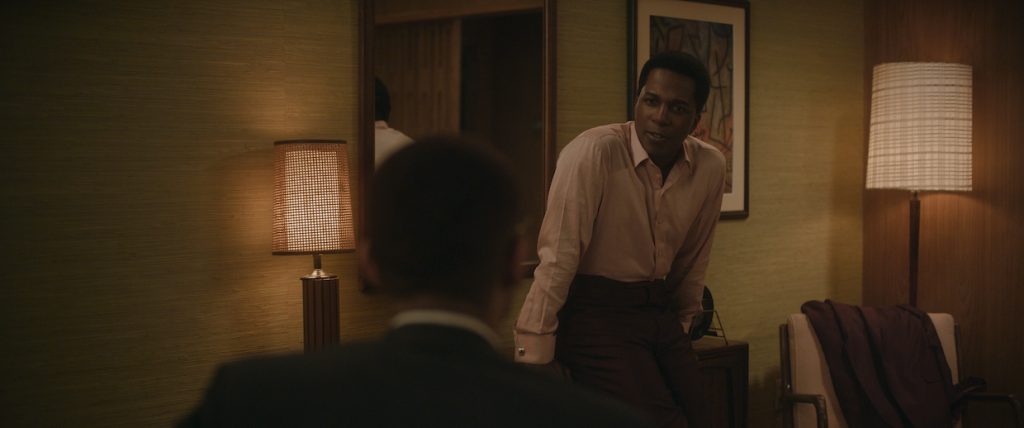
Filmmaker: There are very long dialogue scenes in that hotel room. Were you able to rehearse any ahead of time and get some idea of blocking?
Reiker: The actors were coming from London and LA and they’re all very busy men. So, we did not have them until the night before [the start of principal photography] and really didn’t see it up on its feet until the first morning of shooting. We had these 10 to 12 page dialogue scenes—so many of them, big chunks in the hotel room. Rather than break them up into little bits we would shoot the whole take, then that would inform our coverage. We would watch the monitor during those long masters and see moments where we wanted to go in tighter, moments where we could drift from character to character or where the focus could shift and change perspective.
Filmmaker: So you’d start the day with blocking rehearsals for these long masters?
Reiker: In the morning [director] Regina King would rehearse with them without anybody else in the room and they would work through the scene. Then we would come in to see it up on its feet, adjust the lighting and go from there. Regina definitely wanted the actors to have the space to move around and not have to hit exact marks. They always came very close once the marks were up, but that was the beauty of shooting on two jib arms. The jibs had a five foot swing, so the operators could shift up or down, left or right, and organically react to the actors
Filmmaker: I don’t know if I’ve ever heard of someone shooting a majority of a movie with jib arms like that—with the operators not using remote heads, but just at the end of the jib manually floating the camera. But you used a similar technique on High Art (1998) as well?
Reiker: Yeah, I did that on High Art. It used to be my favorite way to operate because you have control of it; you’re not relying on the dolly grip to back up or move right or move left. You can organically move around the space and move with the actors and go with their action. I hadn’t done it on a movie in a while, but it seemed so perfect for this. Even though it may seem counterintuitive to have a very small room and have two giant pieces of steel in there, it worked. Sometimes the camera movement is almost imperceptible, but it keeps it from being static. It keeps the perspective always shifting.
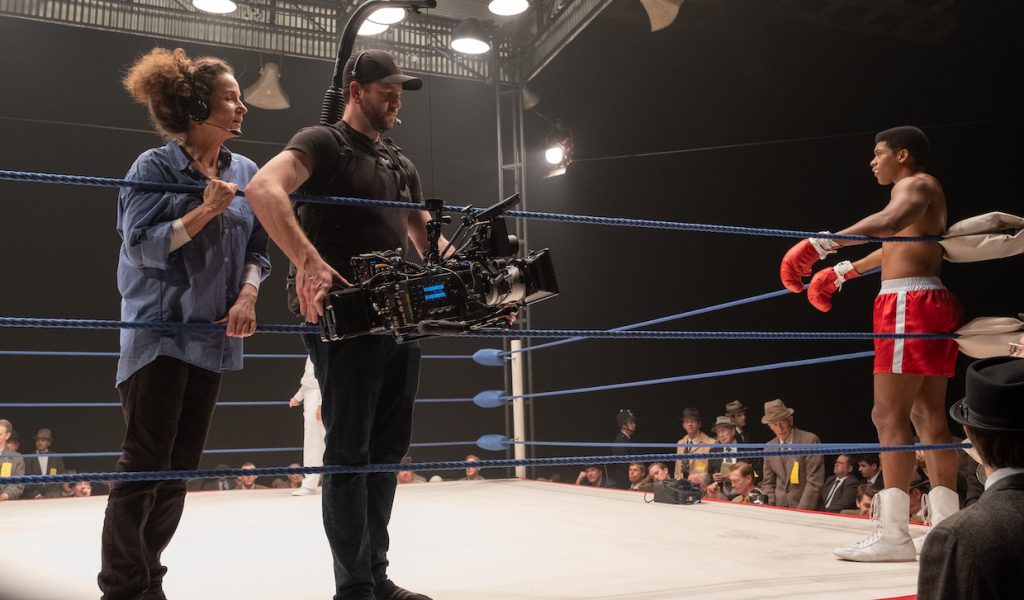
Filmmaker: Well, since you were shooting with Alexa 65s, I’m sure the operators were happy to not be doing 15-minute handheld takes.
Reiker: Yeah, right. (laughs) The boxing scenes were all handheld, though. I loved the work that [A-Camera operator] Chad Chamberlain did for that. We started in the ring with the camera on his shoulder and Regina and I were like, “It just doesn’t feel right. Can you cradle it?” It looked so much better when the camera was below eye level. It just felt more like you were in the ring with them rather than it being on Chad’s shoulder at Cassius’s eye level.
Filmmaker: Did you have to get creative to find ways to get both jibs into the set?
Reiker: The kitchen wall moved in and out really quickly, and the glass on the front window moved in and out really quickly, but otherwise it would take half an hour to pull a wall. Usually we’d set up A camera [in the room] and B camera would come through a hole in the wall where a mirror or picture were on the set. You could pop B camera through one of those holes and that worked really well. They could still have their drifting feeling, but the giant arm wasn’t in the room. We did have to cover both jibs in pink tape to keep people from whacking their heads as they were walking in and out of the set all the time.
Filmmaker: When you were doing the masters, were you putting jibs on opposite sides of the rooms, both on wider lenses, or did you have one that was wider and one that was tighter?
Reiker: We would do a wide and a medium, so a head to toe shot and then the other camera would be waist up or cowboy. There were so many things that would happen that were so beautiful in the first take, then Regina and I would go, “Did you see that? We should keep playing on that. That was amazing.” That could be hard for the operators, because you’d be like, “Okay, about seven minutes in this genius thing happens and I need you to be [in this exact spot and this exact moment to catch it].” But we were all on headsets, so we talked a lot and would say, “Alright, that moment is about to come up. Drift to the right, now drift up.” That really helped. And the ACs were so critical in this. A lot of times Regina would stand next to Sarah Brandes, our 1st AC, and they would talk about [where to focus throughout the scene].
Filmmaker: How did you light that space?
Reiker: The ceilings were only 8 1/2 feet high. We had Astera and Quasar tubes and LiteMats, they all had grids and Magic Cloths on them, and those were our main lights. There was a little bit of light coming from the practicals in the room, but we wanted to keep it all off the walls. Then we had a little eye light, a little scoop light, that we could hang for certain moments if somebody hit a dark spot. There was always one spot in the room where you were like, “Oh no! Don’t go over there!” (laughs) We had a grid on the ceiling so we could quickly hook up a little soft fill light if somebody did go into one of those spots. The gaffer and I were always at the DIT monitor and between takes were always fixing things very quickly.
Filmmaker: You used the Arri DNA lenses. Tell me about those. It’s vintage rehoused glass that’s supposed to be adjustable for each specific shoot.
Reiker: Panavision has these lenses you can adjust and tweak. Now, with this DNA set, Arri can do that too. For One Night in Miami, I knew these four actors were going to take up every inch of our 2.39 frame, so I didn’t want the edges of the lenses to be soft. I wanted them very clean. When I spoke to Arri Rental I said, “I want the cleanest set you have. I don’t want any softness on the corners, because I don’t ever want to have to reframe because the actors are in a soft spot of the lens.” That’s one thing people love about the DNAs—you can tweak them. They also look beautiful on skin. We used a Bronze Glimmer Glass too, which really gave a lot of those [on-camera practical lamps this sort of halo or glow to them. I had used the Glimmer Glass a lot before, but never the Bronze Glimmer Glass.
The only thing that was tricky about the DNAs was that the 110mm was a half stop darker than the other lenses. So, we had to always adjust when that lens would go up. Suddenly you’d look at the monitor and be like, “Oh no! What happened? Did a light go off? Oh….it’s the 110.”

Filmmaker: There are a few instances in the film where you’re recreating well known photos. Tell me about replicating Neil Leifer’s shot from above the ring from the Ali vs. Cleveland Williams fight.
Reiker: That was funny. Our widest lens was a 24mm, I think, and we did all the calculations for the Technocrane that we had that day to make sure we could get to the right height. And we thought, “This is going to be beautiful.” But then we get the camera up there and that lens is just not wide enough. And we’re in New Orleans—we can’t just quickly get another lens. For the Alexa 65, you have to have an adapter. It’s not like the Alexa Mini, where you can just go to any rental house and they’ll have something for you. We ended up taking the camera off of the Technocrane and rigging it from the ceiling and it was perfect. For a scary moment it was like, “Oh my God, are we going to be able to get wide enough?” But the stage we were at had a catwalk and we were able to go up there and literally rig the camera to the catwalk looking straight down.

Filmmaker: Did you shoot both the Ali boxing matches in the same stage, just redressed?
Reiker: Yes, they were in the same stage, redressed and relit. The Clay/Cooper fight [that opens the movie] took place from dusk into night and had a much different feel to it. From all the photographs we were able to completely reconstruct exactly the lighting they had. For the Clay/Liston fight there were also an incredible amount of photos [for reference]. That was interesting, because it seemed very random the way the lights were set up. Half of the lights weren’t even on during the fight. Our gaffer, Allen Parks, was able to find these 1K Altman Scoop Lights, the same exact ones that were used during that fight, and we were able to recreate the whole grid. With the white floor [of the ring], the bounce off that floor just lit everything and even seeped out into the first three or four rows of the audience.
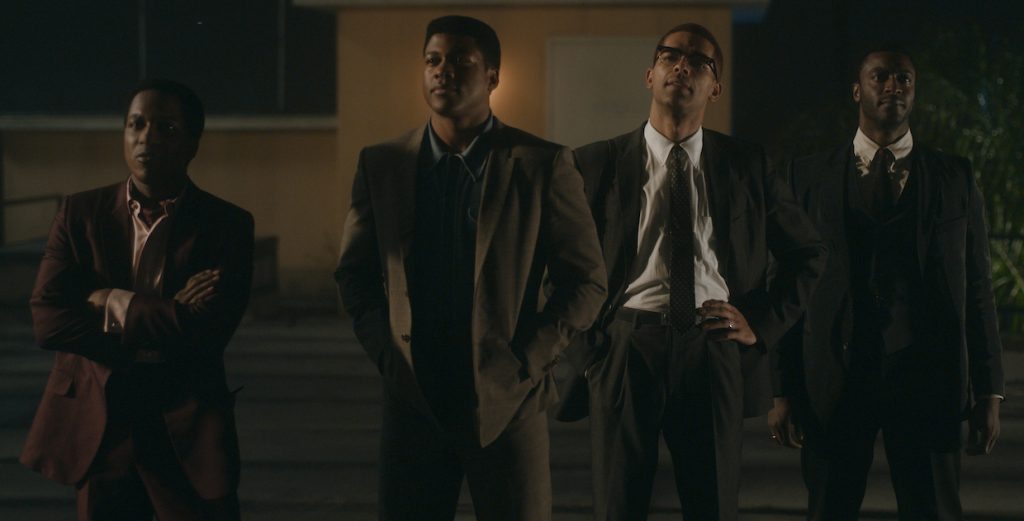
Filmmaker: At one point, the men leave the room and go up on the roof of the motel. You had to get creative for that scene. You couldn’t find a practical roof to use safely, so you brought in shipping containers, bunched them together and created a roof “set.” How did you light that night exterior?
Reiker: We did that in the parking lot outside of our stage in LaPlace. We basically had 280 degrees of darkness, so the gaffer and I decided we would put little pinpoints of light in the distance—he had these little battery operated discs—so there would be some sense of Miami out there. Then [our production designer] Barry brought in palm trees so it would feel like the second floor of the hotel. We had a crane with a soft box that was a three-quarter side light, then one of the electricians hand-carried little scoop lights for eye lights.
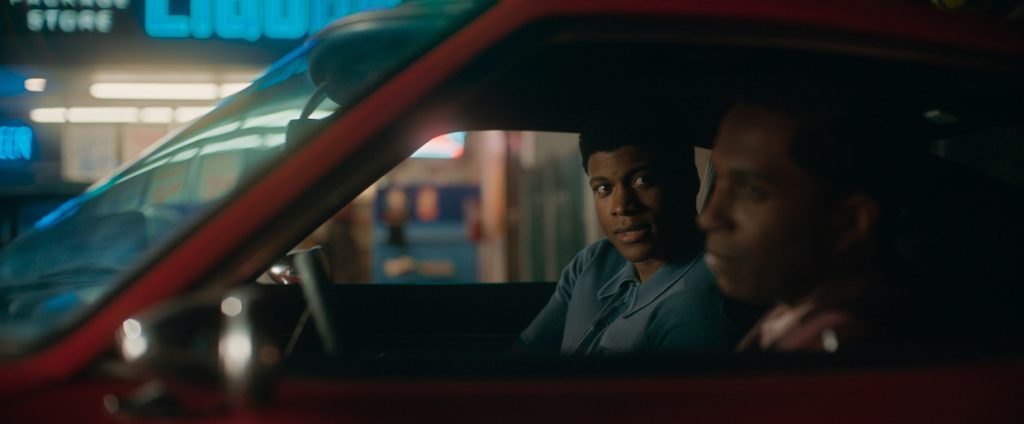
Filmmaker: You started shooting in January of last yea. With two days left on your schedule in March, you got shut down by COVID. When were you able to get back and finish the movie?
Reiker: As soon as LA opened again for filming, we were one of the first crews back, So mid-June. We started on the stage of the Fontainebleau hotel [where Sam Cooke stays in the film, and that was fairly easy. Everyone was just getting used to wearing PPE and the new zones and social distancing. The second day we were at the liquor store location down in Long Beach. I got there around 5pm and the producer came up to me and said, “Your gaffer has been sent home.” And I was like, “What!” This was our big night exterior. One of the rigging electricians had gotten heat stroke and had thrown up, and the gaffer was within ten feet of him, so the COVID compliance officer sent both of them home. Production was like, “Should we call somebody?” And I was like, “It’s 6pm on a Friday night and we’re in Long Beach. Who’s going to want to come down here and stay up all night?” So, we just made it through. The best boy became the gaffer, everyone bumped up and it worked out. We were all just so excited to get this movie finished. After everything that happened during quarantine—with George Floyd and Black Lives Matter—the energy was just like, “We have to get this movie out into the world.”
Matt Mulcahey works as a DIT in the Midwest. He also writes about film on his blog Deep Fried Movies.
